Yellow is a primary color in both RYB (red, yellow, blue) and CMYK (cyan, magenta, yellow and black) color models meaning it cannot be mixed using other colors. I wanted to check if yellow cannot be mixed and ran a few experiments to find what colors make yellow. Here is what I have found.
Mixing green, orange, and white paints yield brownish yellow color that is close to yellow ochre or Indian yellow. A bright yellow color light can be made by overlapping red and green lights, which is not possible by mixing paints. Mixing green and red color paints yield a dark blackish color.
You can also make many shades and tints of yellow color. Knowing different ways of mixing yellow colors and matching the yellow color to a reference are important skills you need to master as an artist.
Two colors that make yellow: orange and green
Yellow color is harder to make by mixing paint or inks. But it can be easily made in the additive color theory where you mix colored light sources. So, the closest that we can get to making yellow with paint or inks is by mixing orange and green colors in equal amounts.
I tried mixing these two colors in acrylic paint. I have recorded the process of making yellow colors with acrylic paint as well as mixing different colors with yellow. If you are interested watch the video below.
Below is the color I got after mixing orange and green together. I have mixed orange and green from the paint tubes as well as orange and green colors that I have mixed to see if there is a difference. I have done this experiment on a glass palette.
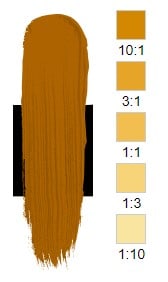
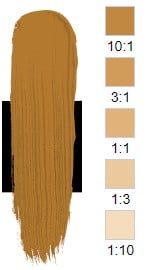
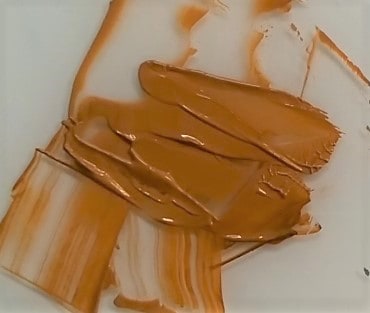
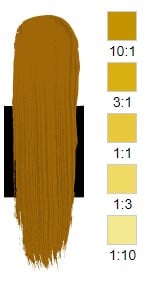
I have used the Golden color mixer to get Indian yellow, yellow ochre, and nickel azo yellow color swatches.
As you can see mixing green and orange gave a brown color. When you mix white with it, it became a light brown color that looks more like yellow ochre, nickel azo yellow, or Indian yellow. However, the color is very muted. The same results were seen for mixed green (blue + yellow) and mixed orange (red+yellow) colors.
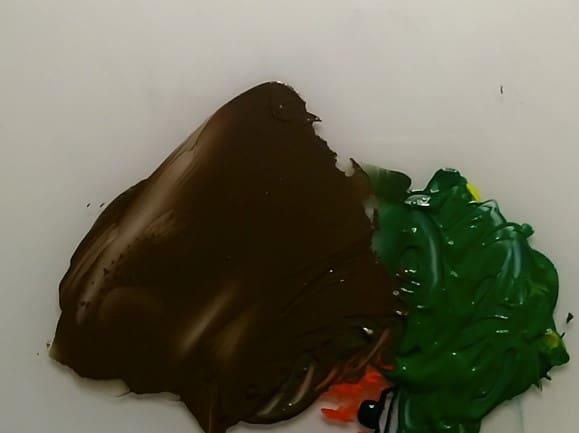
We can conclude that it is very hard to make a vibrant yellow color by mixing other colors. However, if you like a color like yellow ochre in your painting, mixing yellow with green and orange will be a good choice. Especially yellow ochre is best to paint the colored ground (underpainting color).
Therefore what I recommend is buying yellow paint for your paintings. You can get cadmium yellow medium as it is very opaque and can be used with most colors. If you want to make a yellow color like yellow ochre without using yellow, then you can use orange and green to mix it.
I have written a whole article about acrylic paint color mixing charts. You can learn a lot about mixing all the primary and secondary colors there. There is a free downloadable color mixing chart and a grid as well.
In the rest of the article, I will be using different color terminologies like hue, tint, and shade. If you do not understand them, please refer to the color terminologies box below.
Color Terminologies
There are different color terminologies you need to understand when discussing colors. I have described them below;
Hue: Hue means colors such as primary colors( red, blue, yellow) and secondary colors (orange, green, purple).
Value: The darkness or lightness of a color. Every color has a value. You can see this if you see a black and white photo of colors. Light colors like yellow are high in value while darker colors like red are low in value. The color black has the lowest value while the color white has the highest value.
Shade: Shade is the darker color you get when mixing a hue (color) with black. You can make dark to light shades by mixing in more or less black.
Tint: Tint is the color you get by mixing a hue (color) with white. By changing the amount of white you mix, you can get lighter tints.
Mass stone: Color of paint when painted thickly, straight out of the tube without diluting.
Undertone: Undertone can be seen when you scraped the paint on a white surface. Undertones can be different from mass tones because colors are not pure although there is a single pigment. Impurities of some colors give a different undertone. (e.g. Phthalo blue has a dark blue mass tone and greenish undertone)
Color bias: Every color (even primary colors) has a bias towards another color because there are hidden color pigments in the pure colors. (e. g. Phthalo blue has a green color bias while ultramarine blue has either green or red color bias)
Complementary colors: Colors on the opposite side of the color wheel. When complementary colors are mixed, a neutral or muted color will be made.
Cool colors: Cool colors are colors that remind you of the ocean and water. They include blue, green, and purple.
Warm colors: Warm colors will remind you of sun and fire. They are red, orange and yellow.
I have used student-grade acrylic paint for this experiment. As you can see it is thin and transparent at some points. If you want excellent coverage and pigment concentration, go for artist-grade paint.
The best choice for artist-grade acrylic paint that I recommend is Golden acrylic paint (Link to view on Blick Art Material). They are pioneers of acrylic paint and offer the best quality.
If you can not afford artist-grade acrylic paint, you can use high-quality student-grade acrylic paint. I have written a whole article about comparing 5 student grade acrylic paints and picking a winner. You can make the best choice for affordable acrylic paint by reading that article.
Is yellow a primary color that cannot be mixed?
Yellow is a primary color in both CMYK and RYB color systems. CMYK color model uses cyan, magenta, and yellow as primaries. With these primaries, you can create any color you want. RYB color system uses red, blue, and yellow as primaries and you can create most colors but not as many as CMYK colors.

Therefore it is not possible to create yellow from the CMY or RYB primaries. Therefore in the previous section, we have tried to create it by mixing secondary colors green and orange. This is the same method we used to mix blue in the article ‘what colors make blue‘
Yellow + Blue = Green
Yellow + Red = Orange
If we can mute blue from green and red from orange we are left with yellow color. To mute a color you need to mix it with the complementary color. The complementary of blue is orange. So orange will cancel blue. The complementary color of red is green. Green will cancel out red. So neutralized red and blue make a muddy color.
As yellow is a lighter color, the darker muted blue and red colors with a muddy color will overpower yellow. That is why we see an overall brown color. You can lighten it up with a little white. Use titanium white for this.
Mixing yellow light with red and green
Light colors mix according to the additive color theory. This means when you are mixing different colored light sources you are adding up wavelengths together until you get white light. You can understand this with the below image.
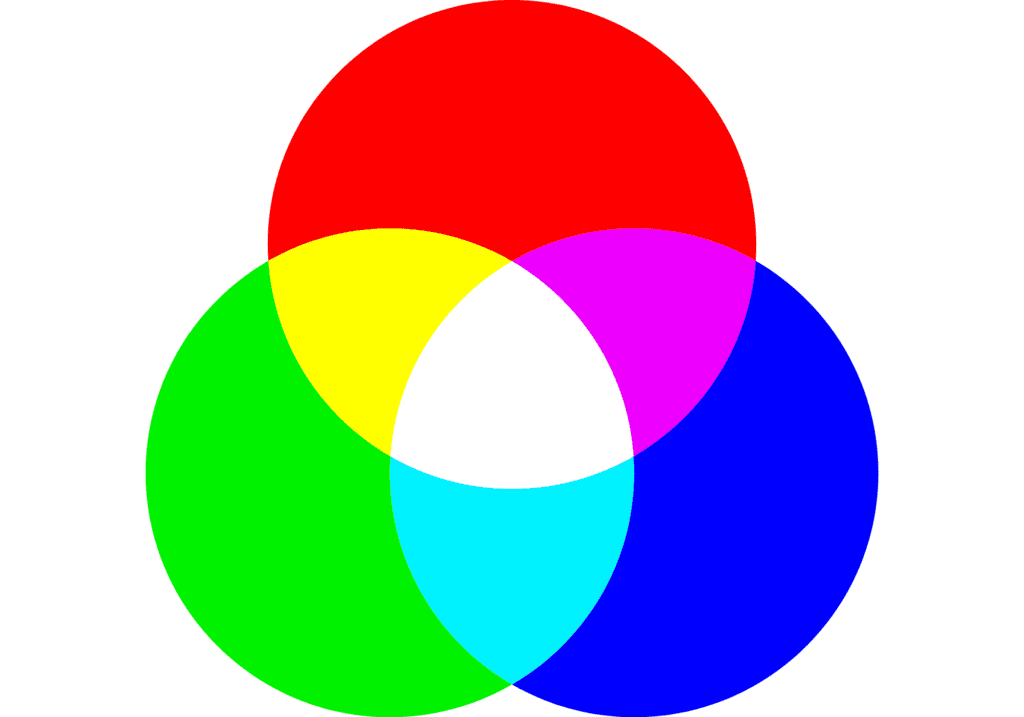
As you can see you can get the exact bright vibrant yellow color by mixing red light and green light. This color model is called RGB (red, green, and blue as primary colors) and is used on digital screens such as the device you are reading this article on.
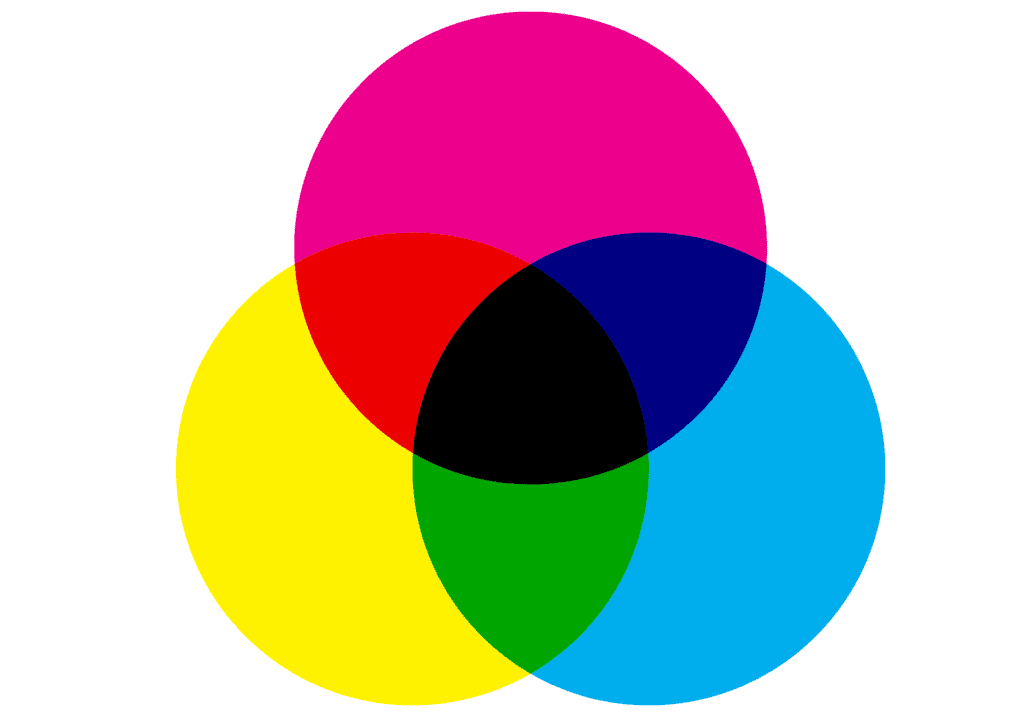
However, the color theory in play when using pigments or paints is the subtractive color theory. This means when you mix colors or pigments it cancels out wavelengths until you are left with black color. You will make darker colors than the initial colors you used when mixing colors.
This is the same reason why we cannot get a vibrant light yellow color when mixing orange and green and yielding a darker brownish color instead. If we mix green and red in hope of getting yellow as in the additive color model we end up with a dark, sort of black color.
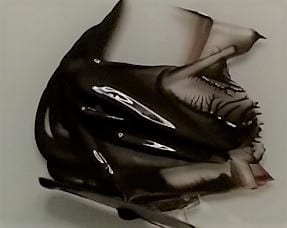
Mixing different shades and tints of yellow
To mix shades of yellow mix yellow with black changing the mixing ratio. By mixing with white different yellow tints can be made. Following are the yellow tints and shades you can obtain with different black and white ratios.
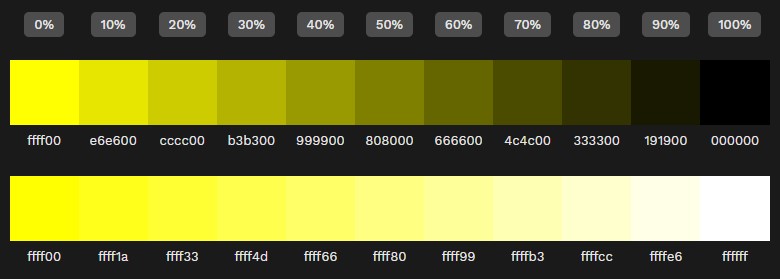
I have used primary yellow for the shades and tints chart because if we used the mixed yellow color it will not work. The brownish-yellow color is dark itself and not essentially necessary to make shades of it. However, some tints of the mixed brownish yellow color can be made.
As you can see when making shades of yellow it is easier to get muddy colors. So, mix a very little black color when making yellow darker. Instead of directly mixing it with black color, you can mix it with grey. It mutes the yellow color very softly. Following is the result I have got with grey and yellow.
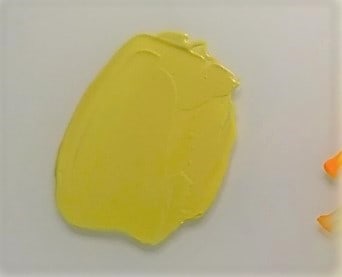
I have also made one tint of yellow color. You can see it from the below image.
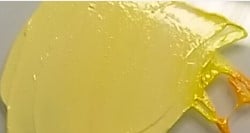
Best way to darken yellow color: mix warmer and cooler yellow
The first thing that comes to our mind when darkening a color is mixing it with black. But black can easily overpower the color you are mixing it with. Also, the color you want to darken will lose all its saturation and vibrancy and look muddy.
Therefore the best way to darken a color is to mix it with the color that is adjacent to it in the color wheel. The color that is adjacent to yellow in the color wheel is orange. So you can get a darker value of yellow by mixing it with orange. This will make yellow warmer.
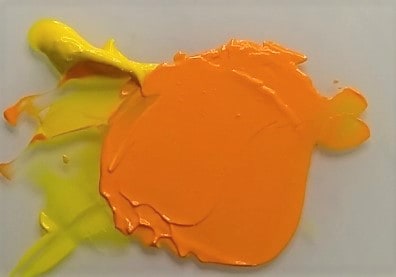
If you want to know how to mix orange colors, you can read the following article; How to make orange with paint? Mixing shades, tints, and hues.
You can also mix yellow with green, again the color that is sitting next to yellow on the color wheel. This way you can get a lower value yellow that is cooler. Mixing cooler and warmer shades of yellow is the best way to darken it. It is true for any color, especially those lighter colors.
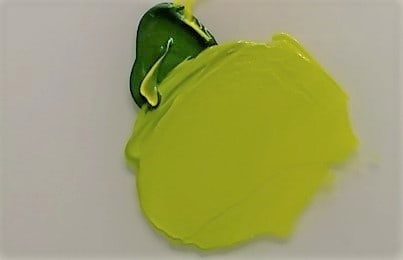
How to mute the yellow color?
You can mute the yellow color by mixing it with its complementary color. The complementary color of yellow according to the color wheel is purple. You can get a muted yellow color by mixing it with purple. Following is the result I got by mixing purple with yellow color.

The color bias of different yellow colors
Every color, even though it is a pure pigment it has a color bias. This happens due to impurities in natural pigments. As an example, cadmium yellow, Winsor Yellow, and Indian yellow have an orange undertone. Thus they are warmer yellow colors. They are best to mix orange colors.
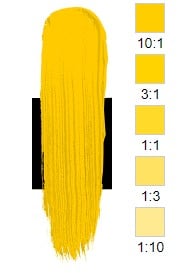
There are cooler yellow colors with a green undertone. Some examples are lemon yellow, bismuth yellow, and cadmium lemon. They are best to mix vibrant vivid green colors.
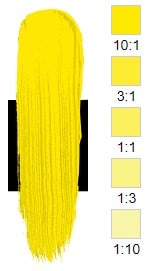
If you go against the color bias of a yellow color or any other color, it is easier to make muddy colors. As an example, if you use cadmium lemon to mix an orange color, it is easier to make the mixed orange color muddy. But if you use the same cadmium lemon to mix green, the green will be vivid, saturated, and vibrant.
Steps of mixing a yellow color to match a reference
Now that we know many things about mixing yellow colors, let’s match a yellow color of a reference photo. There is a set process to this. I will explain it step by step related to the following reference image of a lemon.

Step 1: Make a color wheel with cyan, yellow, and magenta or red, yellow, and blue as the primary colors. You can also refer to the color wheel I have made. It is best when you have a color wheel for the particular paints you are using. The following video will help you make a color wheel.
Step 2: Match the hue of the yellow in the reference photo to a hue in the color wheel. The best match for the yellow hue of lemon is lemon yellow. It is the yellow color I have used as the primary yellow of the color wheel. Use any yellow color that has a green or blue undertone to it. Because the yellow color of lemon is cooler.
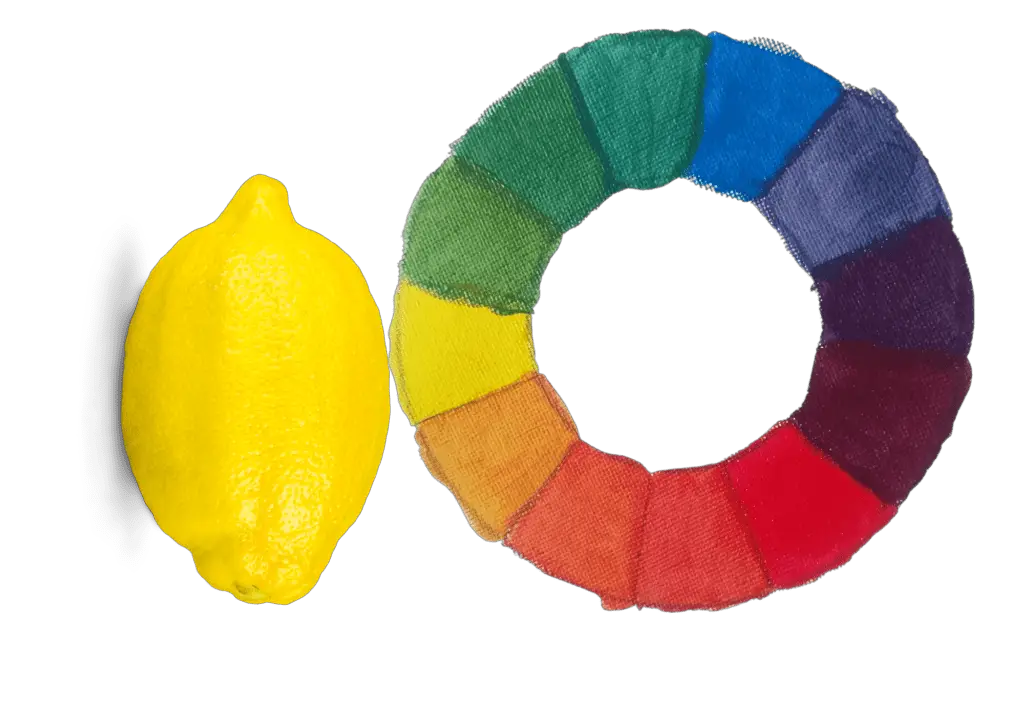
Step 3: Determine the vividness or dullness of the reference color. If it is a dull color you need to mix the complementary colors and mute the yellow hue. As you can see the darker hues of lemon are not very vivid. To mute the lemon yellow color a dash of purple needs to be mixed.
Step 4: Next match the value of the color by mixing in white. I wanted to increase the value of the mixed yellow color for the highlights of the lemon. So I mixed in a very little titanium white. Again the amount you want to mix depends on the quality of the paint you are using.
This way you can change the value of the yellow color mixed to match any color of the lemon. This is the exact process you need to follow to match any color to a reference.
Mixing different hues of yellow using different yellows
There are different hues of yellow color. You can mix different hues of yellow by mixing yellows straight out of the tube rather than using the primary colors. You can adjust the value and vividness of colors also. Let’s get into making different interesting hues of yellow.
I have also included the hex code, CMYK, and RGB values as well so that you can try mixing them from the primary colors. I have also mentioned the paints you need to mix to get a particular yellow color.
The paints I have mentioned below are related to Golden Heavy Body Acrylic paints. But it is highly related to the same color of different types or brands of paint.
Pastel yellow: Mix 1 Cad Yellow Primrose * 2 Zinc White
Hex #FFFE71
RGB 255, 254, 113
CMYK 0, 0, 56, 0
Orange-yellow: Mix 1 Indian Yellow Hue * 1 Hansa Yellow Opaque * 1 Titanium White * 1 Diarylide Yellow
Hex #FFAD01
RGB 255, 173, 1
CMYK 0, 32, 100, 0
Mellow yellow: Mix 43 Zinc White * 3 Cad Yellow Medium * 3 Naples Yellow Hue * 1 Green Gold
Hex #F8DE7E
RGB 248, 222, 126
CMYK 0, 10, 49, 3
Peach: Mix 27 Titanium White * 5 Light Orange * 1 Cadmium Yellow Light
Hex #FFE5B4
RGB 255, 229, 180
CMYK 0, 10, 29, 0
Butter Yellow: Mix 2 Light Bismuth Yellow * 1 Cad Yellow Primrose
Hex #FFFD74
RGB 255, 253, 116
CMYK 0, 1, 55, 0
Golden yellow: Mix 3 Primary Yellow * 1 Zinc White
Hex #FFDF00
RGB 255, 223, 0
CMYK 0, 13, 100, 0
Naples yellow: Use Naples Yellow acylic color
Hex #FADA5E
RGB 250, 218, 94
CMYK 0, 13, 62, 2
Indian yellow: Use Indian Yellow acrylic color
Hex #E3A857
RGB 227, 168, 87
CMYK 0, 26, 62, 11
Lemon yellow: Use Cadmium Lemon acrylic color
Hex #FDFF00
RGB 253, 255, 0
CMYK 1, 0, 100, 0
Sunshine yellow: Mix 9 Cad Yellow Primrose * 1 Light Bismuth Yellow
Hex #FFFD37
RGB 255, 253, 55
CMYK 0, 1, 78, 0
As you can see, many yellow colors needed cadmium yellow to mix. This can be cadmium yellow medium or cadmium yellow primrose. Hence consider adding them to your color collection. You can mix in some blue to make the yellow color cooler.
Meaning of different yellow hues, shades, and tints
Yellow is needed to create different moods and effects in the painting. It is one of the most used paint for an artist after white. Below I have included a table with different yellow hues and where they are best suited to your artwork.
| Yellow color | Hex code | What the color represents |
| Pastel yellow | #FFFE71 | This light delicate yellow color with a green undertone evokes a sense of calmness and balance |
| Orange-yellow | #FFAD01 | This dark yellow color evokes feelings of excitement, enthusiasm, and happiness |
| Mellow yellow | #F8DE7E | This light yellow color evokes feelings of relaxation |
| Peach | #FFE5B4 | These pastel peach colors remind us of friendliness, sweetness, and encouragement |
| Butter Yellow | #FFFD74 | This yellow color of butter has a greener undertone and evokes feelings of calmness |
| Golden yellow | #FFDF00 | This warm vivid yellow color represents courage, love, passion, and wisdom |
| Naples yellow | #FADA5E | This warm light yellow color is used by artists instead of the overpowering white color, it evokes a feeling of peacefulness |
| Indian yellow | #E3A857 | This dark orange-yellow color represents purity and victory |
| Lemon yellow | #FDFF00 | This pale yellow color with a green undertone is the color of lemon and is used to represent joy, enthusiasm, and friendship |
| Sunshine yellow | #FFFD37 | The color of sunshine represents positivity, energy, happiness, enlightenment, and freshness |
You can use these different yellow colors in your paintings as mentioned above to create different effects and evoke different feelings.
Conclusion
Yellow color can be made by mixing green, orange, and white colors. However, this mixed color is closed to yellow ochre, Indian yellow, or nickel azo yellow. This means you cannot mix the primary yellow color which is bright and vibrant by mixing two other colors. However, you can mix a darker less vibrant brownish yellow color with green and orange.
